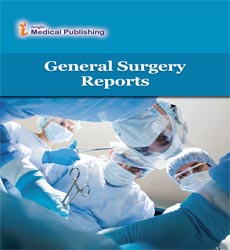Advancements in Allogeneic and Xenogeneic Tissue Usage in Plastic and Reconstructive Surgery
Adebayo Ade*
Department of Surgery, University of Toronto, Ontario, Canada
- *Corresponding Author:
- Adebayo Ade
Department of Surgery,
University of Toronto, Ontario,
Canada,
E-mail: ade@gmail.com
Received date: November 14, 2023, Manuscript No. IPGSR-23-18477; Editor assigned date: November 16, 2023, PreQC No. IPGSR-23-18477 (PQ); Reviewed date: November 30, 2023, QC No. IPGSR-23-18477; Revised date: December 07, 2023, Manuscript No. IPGSR-23-18475 (R); Published date: December 14, 2023, DOI: 10.36648/ipgsr.7.03.143
Citation: Ade A (2023) Advancements in Allogeneic and Xenogeneic Tissue Usage in Plastic and Reconstructive Surgery. Gen Surg Rep Vol.7 No.03:143.
Description
The abundance of allogeneic and xenogeneic tissue items accessible to plastic and reconstructive specialists has considered the advancement of novel careful answers for testing clinical issues, frequently blocking the need to cause contributor site horribleness. Allogeneic tissue utilized for reconstructive medical procedure enters the tissue business through entire body gift or conceptive tissue gift and has been controlled by the FDA as human cells, tissues, and cell and tissue-based items starting around 1997. Tissue banks offering allogeneic tissue can likewise go through deliberate guideline by the American Relationship of Tissue Banks (AATB). Tissue ready for transplantation is sanitized and can be handled into delicate tissue or bone allografts for use in careful reproduction, while non-relocate tissue is ready for clinical preparation and medication, clinical gadget, and translational exploration. Xenogeneic tissue, which is most frequently gotten from porcine or ox-like sources, is additionally industrially accessible and is dependent upon severe guidelines for creature rearing and evaluating for irresistible illnesses.
Allogeneic Tissue
Albeit xenogeneic items have generally been decellularized for use as non-immunogenic tissue items, ongoing advances in quality altering have made the way for xenograft organ transfers into human patients. Thus, we depict an outline of the cutting edge obtaining, guideline, handling, and utilizations of tissue items applicable to the field of plastic and reconstructive medical procedure. Products derived from human tissue are referred to as allogeneic tissue products because they are obtained from a person of the same species but with different genetics. In the clinical setting, allogeneic tissue can be utilized as an allograft or as a tissue transfer from one individual to another. The joined work of George Schöne, James B. Murphy, and Peter Medawar shaped the establishment for immunologic resistance and immunosuppression, making ready for the principal effective allogeneic tissue. There has been a push to increment variety across medication. Race concordant visits are related with higher view of doctor support, expanded patient adherence and expanded fulfillment. This prompts more productive and practical consideration. Minority doctors are bound to rehearse in underserved networks with patients of comparative foundations, further solidifying the significance of expanding variety in the calling. The upgrades in variety inside medication are obvious by ladies containing more than half of clinical understudies along with more than 40% of careful occupants and colleagues. Be that as it may, underrepresented minority understudies and students have not exhibited comparative advancement. Over the past few decades, the proportion of black and hispanic faculty members has decreased.
Racial Disparities
In surgical leadership, significant gender and racial disparities persist. 79% of scholarly general a medical procedure division seats are non-Hispanic White and 85% male. Comparable investigations of different strengths bear similar to results. The portrayal of ladies and URM as broad medical procedure residency program chiefs falls behind their impression in the field. Examinations of ladies as broad medical procedure partnership PD from 14 different sub-strengths have yielded comparative outcomes. The Americas Hepato-Pancreato-Biliary Affiliation (AHPBA) and American Culture of Relocate Specialists have laid out a few boards of trustees, initiative foundations, and drive to advance variety in the hepatopancreaticobiliary and relocate a medical procedure labor force. The creation of pipelines for women and URM surgeons' training has been a priority for both organizations. Ladies address under 20% of HPB association program chiefs. Notwithstanding, stomach relocate a medical procedure partnership administration stays obscure. We plan to measure the orientation and racial variety among stomach relocates a medical procedure cooperation program chiefs. As a benchmark for comparing future progress and developments in HPB and transplant surgery, this investigation presents the current landscape of abdominal transplant fellowship leadership. Vitiligo that is both stable and recalcitrant can be treated with the MKTP procedure. The procedure's success is unpredictable, despite careful candidate selection based on clinical stability. The point of our review was to characterize the immunological profile of stable vitiligo sores going through MKTP and connect them with clinical results. We included 20 MKTP competitors with vitiligo and a patient with piebaldism as a control. Preceding MKTP, Lymphocyte subsets and chemokines in the beneficiary skin were estimated by stream cytometry and ELISA. Flow cytometry was used to measure the donor skin's melanocytes during MKTP. After MKTP, patients were followed for a considerable length of time and repigmentation was evaluated clinically and by investigation of clinical photos. Gauge immunologic biomarkers, span of clinical dependability, and relocated melanocyte number were corresponded to postsurgical repigmentation scores. In 43% of vitiligo lesions that were clinically stable, CD8+ T cells were elevated. CD8+ Immune system microorganism number adversely associated with postsurgical repigmentation scores. Length of clinical strength, skin chemokines, and relocated melanocyte number didn't impact postsurgical regimentation. This study shows that CD8+ Immune system microorganism number corresponds adversely with outcome of postsurgical regimentation and can be a biomarker to distinguish ideal careful up-andcomers.
Open Access Journals
- Aquaculture & Veterinary Science
- Chemistry & Chemical Sciences
- Clinical Sciences
- Engineering
- General Science
- Genetics & Molecular Biology
- Health Care & Nursing
- Immunology & Microbiology
- Materials Science
- Mathematics & Physics
- Medical Sciences
- Neurology & Psychiatry
- Oncology & Cancer Science
- Pharmaceutical Sciences
